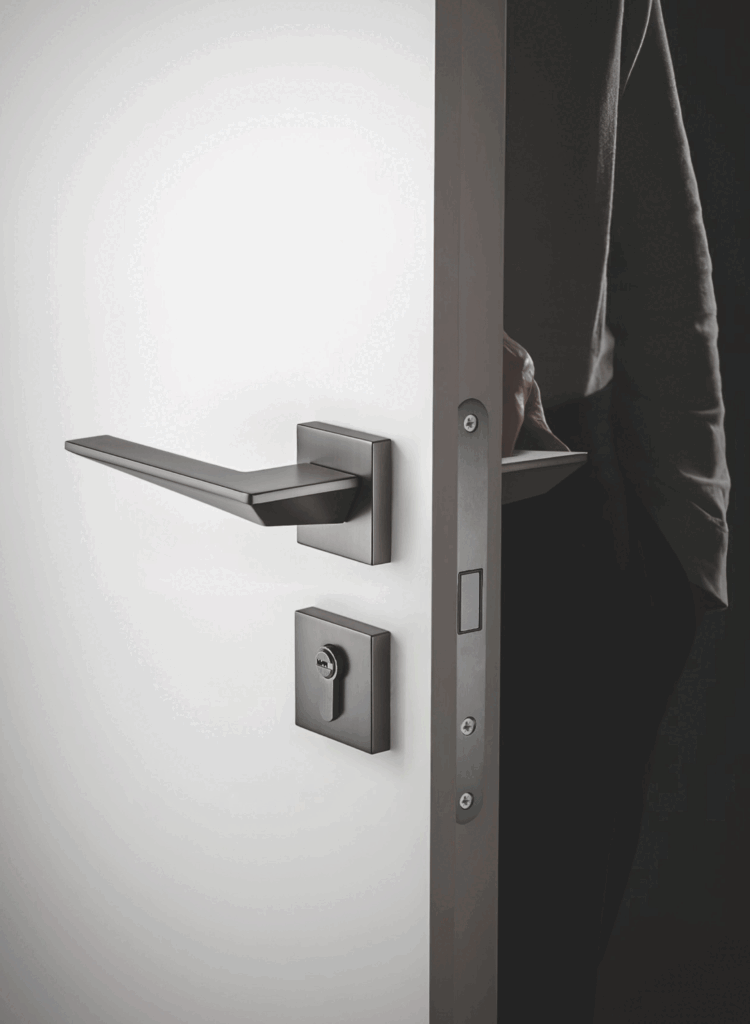When it comes to door hardware, standards matter. DIN EN 1906 is a vital guideline that defines the performance requirements for door handles and levers. This standard ensures safety, durability, and functionality, making it crucial for manufacturers and suppliers in the industry.
What is DIN EN 1906?
DIN EN 1906 is a European standard that specifies the quality and performance criteria for door handles. It applies to various types of door handles, including those used in residential and commercial settings. This standard categorizes handles based on their intended use, ensuring they meet specific durability and safety requirements.
Classification
Door hardware tested according to DIN EN 1906 must be marked with an 8-digit classification code:
| Digit | 1 | 2 | 3 | 4 | 5 | 6 | 7 | 8 |
|---|---|---|---|---|---|---|---|---|
| Category of use | Durability | Door mass | Fire resistance | Safety | Corrosion resistance | Security | Type of operation | |
| Grade | Four grades | Two grades | / | Five grades | Two grades | Five grades | Five grades | A/B/U |
Categories of use
Residential (Grade 1)
- Application: Suitable for interior doors in residential buildings.
- Characteristics: Designed for light to moderate usage, often used in homes and apartments.
Commercial (Grade 2)
- Application: Ideal for commercial settings, including offices and retail spaces.
- Characteristics: Built for moderate to heavy usage, ensuring durability and reliability.
Heavy Duty (Grade 3)
- Application: Designed for high-traffic environments, such as schools, hospitals, and public buildings.
- Characteristics: Engineered for heavy usage, providing maximum durability and strength.
Special Applications:(Grade 4)
- Application: Includes handles designed for specific environments, such as fire-rated doors or accessibility features.
- Characteristics: These products meet additional safety and regulatory requirements.
Durability
Grade 6:
- Usage: Up to 100,000 cycles.
- Application: Designed for heavy-duty applications, such as public buildings and high-traffic areas.
Grade 7:
- Usage: Up to 200,000 cycles.
- Application: Best for very high-traffic environments, like airports, hospitals, and schools.
Door mass
No classification criteria
Fire resistance
Grade 0:
- Description: No performance determined.
- Application: Used where fire resistance is not applicable.
Grade A:
- Description: Suitable for smoke-control doors.
- Application: Ensures that smoke does not pass through during a fire.
Grade A1:
- Description: For smoke-control doors tested with 200,000 cycles.
- Application: Provides assurance of performance under both fire and usage conditions.
Grade B:
- Description: For smoke-control and fire-resistant doors.
- Application: Ensures functionality during a fire, preventing the spread of smoke and flames
Grade B1:
- Description: For smoke-control and fire-resistant doors tested with 200,000 cycles.
- Application: Combines durability with fire resistance.
Grade C:
- Description: For smoke-control and fire-resistant doors requiring fire protection inlays in backplate, rose, and escutcheon.
- Application: Enhances fire protection while maintaining functionality.
Grade C1:
- Description: For smoke-control and fire-resistant doors requiring fire protection inlays, tested with 200,000 cycles.
- Application: Ensures robust performance and fire safety.
Grade D:
- Suitable for fire/smoke door assemblies with a steel core in the handle
Grade D1:
- Same as D, plus tested on a test door for 200,000 cycles
Safety
- Grade 0: Normal use
- Grade 1: Safety applications
Corrosion resistance
- Grade 0: No corrosion protection; not suitable for external use.
- Grade 1: Basic indoor protection; minimal resistance to corrosion.
- Grade 2: Moderate resistance; suitable for sheltered outdoor environments.
- Grade 3: Good resistance; appropriate for standard outdoor applications.
- Grade 4: High resistance; ideal for more challenging environments.
- Grade 5: Very high resistance; designed for severe and coastal conditions.
Security
- Grade 0: Basic security; suitable for low-risk areas with minimal access control.
- Grade 1: Increased security; provides better protection against casual attempts of unauthorized access.
- Grade 2: Moderate security; designed for areas with a moderate risk of unauthorized entry.
- Grade 3: High security; offers significant resistance to forced entry and manipulation.
- Grade 4: Very high security; intended for high-risk areas, providing the utmost protection against sophisticated attacks.
Type of operation
- Type A: spring assisted furniture.
- Type B: spring loaded furniture.
- Type U: un-sprung furniture.
The Benefits of Choosing DIN EN 1906 Certified Handles
1. Reliability
When you choose handles that meet DIN EN 1906 standards, you invest in reliability. These products are tested to endure the rigors of daily use, providing peace of mind for manufacturers and end-users alike.
2. Enhanced Reputation
For brands, offering DIN EN 1906 certified handles enhances your market reputation. It signals to customers that you prioritize quality and safety, setting you apart from competitors.
3. Compliance with Regulations
Adhering to this standard helps ensure compliance with local regulations. This is particularly important for procurement managers in construction and building supply who must meet specific guidelines.
Conclusion
Choosing door handles that comply with DIN EN 1906 is essential for ensuring quality, safety, and durability. As a supplier of a wide range of door hardware—mechanical locks, handles, hinges, peepholes, and door closers—we are committed to offering products that meet these rigorous standards. For more detailed information on EN1906, refer to the European Committee for Standardization.
Investing in DIN EN 1906 certified door handles is not just a choice; it’s a commitment to excellence. If you’re looking for reliable and high-quality door hardware, reach out today, and let’s explore how we can support your projects with our top-tier products!
Share This Story, Choose Your Platform!

